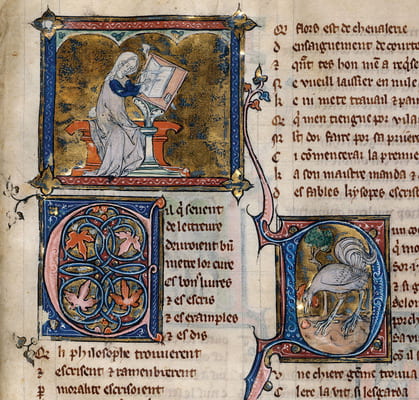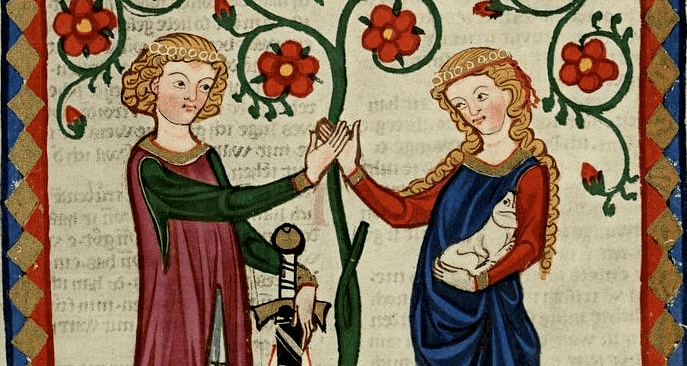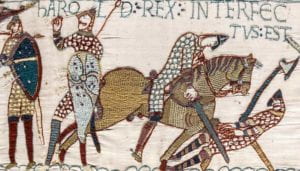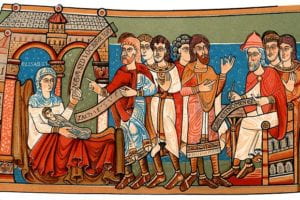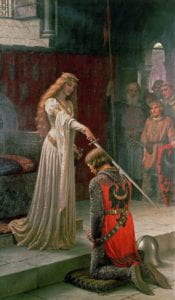| Category | Text |
| Form | Poetry |
| Genre | Romance |
| Author | Pearl Poet / Gawain Poet |
| Time | Late 14th Century |
| Language | Middle English |
| Featured In | Medieval Romance: Magic and the Supernatural (YHU2309); Real and Imagined Animals in Medieval Literature (YHU2330) |
Sir Gawain and the Green Knight is one of the most renowned Arthurian Romances of all time. Written in alliterative verse, the narrative stars the titular Sir Gawain, one of the knights from King Arthur’s Round Table, who accepts the challenge of a strange entity known as the Green Knight – who invites any courageous knight to strike at him with an axe, knowing that they must allow the Green Knight to return the gesture in a year and a day. The text is written by an unknown author, who is thought to also have penned another famous Middle English poem, Pearl.
REFLECTIONS AND ENGAGEMENT
The text of Sir Gawain and the Green Knight was quite popular across all courses and classes that featured it. A class activity took place in the Spring 2020 iteration where students formed groups to reimagine the text as a movie and to film movie trailers for their different visions.
An example of one of the trailers filmed for the class by YAP JIA YI (’21), NIKKI YEO YING YING (’22), & TOH HONG JIN (’23).
THE GREEN KNIGHT
“A text is a weave of knowing and not-knowing.”1 As stated by critic Geraldine Heng with regards to Sir Gawain and the Green Knight, the narrative is full of unanswered questions. The Green Knight is a mysterious character both known and unknowable. His first appearance is a shock to Arthur’s court, and though we eventually glean some insight as to his origins, there still lurks questions, such as: why does Morgan le Fay hate Guinevere? How does Guinevere react? The binaries of knowing and not-knowing form a compelling narrative.
With the text described as a “weave,” I was inspired to embroider. In fact, various narratives refer to embroidery as a medium for communication. For instance, in the Middle English Breton Lai Emare, Emare’s luxuriously embroidered robe plays a central role in the narrative. The robe depicts different pairs of lovers. With its images of true loves, the robe becomes representative of a “gallery of ideals,” integral to the romance of the story.2 Embroidery was a common pastime for women in the Medieval period, akin to a symbol of status. Embroidered items were often created with expensive materials like silk, silver or gold, and given as presents to promote the political interests of the family. A valuable gift, embroidery was a medium of communication, signalling friendly intentions and furthering alliances.3 In embroidery, various stitches are used; the split stitch was popular in Medieval England, and so I mainly used this stitch, as seen in the border and leaves.4
Regarding the Green Knight, what struck me was the ambiguity of what he represented. While at first an ominous appearance in Arthur’s court, by the end of the tale, we learn he is the friendly lord who welcomed Gawain into his court. In fact, the Green Knight possesses many paradoxical qualities, seen in lines 151-220, expounding his appearance in excruciating detail. He is green and supernaturally strong, yet appears human at the same time. He appears offering symbols of peace (the holly sprig) and of violence (the axe). He could be good or evil. As such, I decided to focus on embroidering just the Green Knight, although in the narrative, he enters Arthur’s court on his green horse. Moreover, I kept his face empty, in order to underscore the mystery of his identity—Arthur’s court knows nothing about the Green Knight’s origins when he first arrives.
The most striking aspect of the Green Knight is, as his name suggests, that he is entirely green. Specific shades of green are mentioned; he is the green of nature, be it “forest-green” or “grass-green” (lines 220 and 235). To highlight the greenness of the knight, I decided to use green cloth for the background, overtly highlighting the green-ness of the Green Knight and the overall piece. The only parts of the piece that are not green are the gold accents and the items he wields.
THE GREEN KNIGHT: THE LIMITATIONS OF HUMAN CAPACITY
In ‘Sir Gawain and the Green Knight,’ the Green Knight taunts the Arthurian court by using his grandeur to emphasize their shortcomings and haunts Sir Gawain, who comes to fear his mortality at the Green Knight’s hands. As I carried the Pearl poet’s Green Knight in my mind across the weeks, I realized that his existence is a direct challenge to the limitations of human capacity. I hoped to capture this aspect of the Green Knight’s existence in physical recreation. I have created a model out of crushed papers, fallen leaves, and green plastic bags in my creative interpretation. His armor is made of leaves painted over in green to cast them as “evergreen,” and as per the description in the text, the Green Knight remains shoeless. He is beheaded, holding his head – wrapped in green plastic – by his side. He has a red braid around his waist and decapitated head. My creative decisions in making this model are products of much deliberation. As this essay proves, my decisions document the dilemmas I faced as I worked within my own human capacity limitations.
From the introduction of the Green Knight, he is set apart from the knights of the Arthurian court in how massive his stature is. The first descriptions of the Knight depict him as “a mountain of a man, immeasurably high, / a hulk of a human” (lines 137-138), placing him (literally) a head and shoulders above the other knights. To attempt to capture this “most massive man” (line 141), I set out to create a model as large and sturdy as I could make it. The model is big – I was indeed questioned by passersby, who noticed I was carrying a rather large (and green) model of a man back and forth from the Art Studio. However, I admit he is not as large as I would have liked him to be. Running into issues of storage, transportation, and resource shortages pointed me to the limitations of my own capacity. I also planned to make this model out of wood to give him the bulk and durability that his title as the “mightiest of mortals” (line 141) commands. However, a lack of resources and expertise led me to use crushed papers to construct the base – unfortunately, making my model extremely flimsy. Again, I faced limitations in what I was capable of creating. In this trial-and-error process, I realized that these were uniquely human problems that curtailed how large and sturdy I could make the model I created with my own hands. I doubt nature runs into such issues in creating features of the natural world. Thus, in this failed venture of recreating the physicality of the Green Knight, I paralleled the Arthurian knights in my realization that I could not recreate his build in the same way the knights could not match the Green Knight’s stature.
FOOTNOTES
1 Heng, Geraldine. “Feminine Knots and the Other Sir Gawain and the Green Knight.” PMLA, vol. 106, no. 3, 1991, pp. 500–14, https://doi.org/10.2307/462782.
2 Mortimer J. Donovan, “Middle English Emare and the Cloth Worthily Wrought,” in Larry D. Benson, ed., The Learned and the Lewed: Studies in Chaucer and Medieval Literature, Harvard English Studies 5 (Cambridge: Harvard University Press, 1974), p. 339.
3 Diener, Laura Michele. “Sealed with a Stitch: Embroidery and Gift-Giving among Anglo-Saxon Women.” Medieval Prosopography, vol. 29, 2014, pp. 1–22, http://www.jstor.org/stable/44946967.
4 See https://youtu.be/JgN7osGCf5g for a tutorial.
5 Besserman, Lawrence. “The Idea of the Green Knight.” ELH, vol. 53, no. 2, 1986, pp. 219–39, https://doi.org/10.2307/2873255.
REFERENCES
Armitage, Simon. Sir Gawain and the Green Knight. W. W. Norton & Company, Inc., 2008.
Besserman, Lawrence. “The Idea of the Green Knight.” ELH, vol. 53, no. 2, 1986, pp. 219–39, https://doi.org/10.2307/2873255.
Diener, Laura Michele. “Sealed with a Stitch: Embroidery and Gift-Giving among Anglo-Saxon Women.” Medieval Prosopography, vol. 29, 2014, pp. 1–22, http://www.jstor.org/stable/44946967
Heng, Geraldine. “Feminine Knots and the Other Sir Gawain and the Green Knight.” PMLA, vol. 106, no. 3, 1991, pp. 500–14, https://doi.org/10.2307/462782.
Mortimer J. Donovan, “Middle English Emare and the Cloth Worthily Wrought,” in Larry D. Benson, ed., The Learned and the Lewed: Studies in Chaucer and Medieval Literature, Harvard English Studies 5 (Cambridge: Harvard University Press, 1974), p. 339.
IMAGE CREDITS
[Featured Image] https://en.wikipedia.org/wiki/Sir_Gawain_and_the_Green_Knight
CONTRIBUTED BY ASHLEY TAN (’25), OSHEA REDDY (’24), YAP JIA YI (’21), NIKKI YEO YING YING (’22), & TOH HONG JIN (’23)






